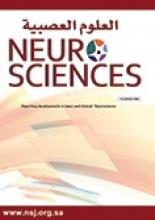Abstract
OBJECTIVE: Although tetanus is now uncommon in Oman (The Expanded Program on Immunization was introduced in 1981), patients continue to present from time to time at an average rate of 6 cases per year. Worldwide, the mortality rate for tetanus remains high (ranging from 15-20% in developed countries). At the Sultan Qaboos University Hospital, Muscat, Oman, prolonged Intensive Care Unit treatment and multi-disciplinary management is invariably required for tetanus patients. This study was carried out to evaluate our results over the past decade.
METHODS: All tetanus patients admitted to the Sultan Qaboos University Hospital from 1991 up to the end of 1999 were retrospectively reviewed. Patients were diagnosed early, and aggressive treatment in the Intensive Care Unit was instituted, with a coordinated multidisciplinary management.
RESULTS: Ten cases were identified and included in the review, comprising 9 adults and one infant aged 2 weeks. Adult patients were aged 36-75 years (mean 59 years), and the average Intensive Care Unit stay of the 9 surviving patients was 5.5 weeks (range 3-7 weeks). All patients presented with severe generalized tetanus. Two patients with traditional cautery marks developed tetanus. A focus of infection could not be found in 2 patients. All patients had early tracheostomy and assisted ventilation with appropriate sedation. One patient required almost 45 gm of diazepam throughout his Intensive Care Unit stay. One adult patient died on the 6th day of admission following myocardial infarction. The neonatal case survived after 35 days care in the Intensive Care Unit. The mortality rate for our patients was therefore 10%.
CONCLUSION: Tetanus in Oman remains an infrequent but important disease requiring costly and prolonged Intensive Care Unit treatment. We attribute the comparatively low mortality rate (10%) in this study, to early diagnosis, institution of aggressive treatment, good nursing as well as a well-coordinated multi-disciplinary management.
- Copyright: © Neurosciences
Neurosciences is an Open Access journal and articles published are distributed under the terms of the Creative Commons Attribution-NonCommercial License (CC BY-NC). Readers may copy, distribute, and display the work for non-commercial purposes with the proper citation of the original work.






